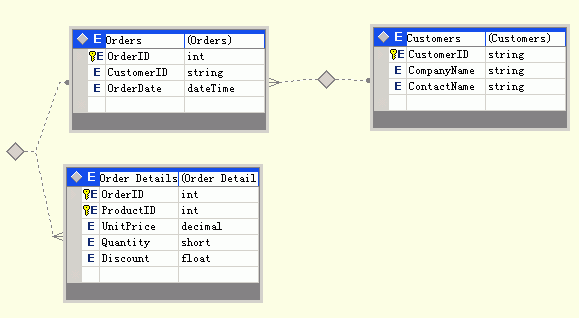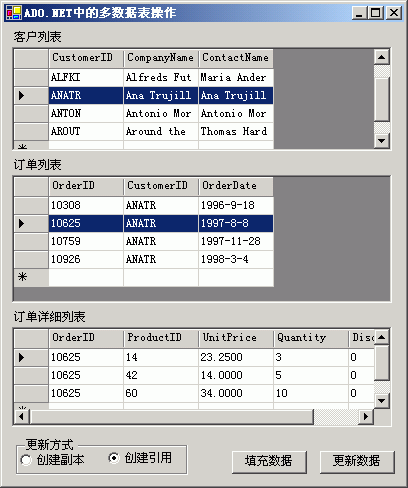ADO.NET中的多数据表操作浅析之读取
在开发基于.NET平台的数据库应用程序时,我们一般都会用到DataSet,作为ADO.NET的核心类它为我们提供了强大的功能,而整个看上去就像是放在内存内的一个小型数据库,内部包括了DataTable、DataView、DataRow、DataColumn、Constraint以及DataRelation。当初看到它时真的是有点兴奋。
下面根据我的一些经验来举例说明在ADO.NET中的多表填充、关联表更新以及多个Command对象执行过程中启用事务的操作。欢迎大家交流,或在Blog上留言。
一、准备工作
对于NorthWind数据库大家都比较熟悉,所以这里拿它为例,我把Customers(客户表)、Orders(订单表)、Order Details(订单详细表)合起来建立了一个类型化的数据集,类型名称为DatasetOrders,每个表只包括一些字段,下面是在Visual Studio .NET中建立的一个截图:

图1-1
上面建立了两个关系表示为Customers —> Orders —>Order Details。因为Orders表的OrderID字段为自动增长列,这里把就把它的AutoIncrementSeed和AutoIncrementStep值设置成了-1,这在实际添加订单的过程中可能会比较明显,不过不设也没问题。
二.填充数据集
建立一个窗体程序来演示实际的操作,界面如下:

图2-1
整个应用程序就是一个Form,上面的三个DataGrid分别用来显示相关表的数据,不过他们是互动的。另外的两个单选框用来决定更新数据的方式,两个按钮正如他们的名称来完成相应的功能。
这里我们用一个DataAdapter来完成数据集的填充,执行的存储过程如下:
AS
SELECT CustomerID,CompanyName,ContactName FROM Customers WHERE CustomerID LIKE ' A% '
SELECT OrderID,OrderDate,CustomerID FROM Orders WHERE CustomerID IN
( SELECT CustomerID FROM Customers WHERE CustomerID LIKE ' A% ' )
SELECT OrderID,ProductID,UnitPrice,Quantity,Discount FROM [ Order Details ] WHERE OrderID IN
( SELECT OrderID FROM Orders WHERE CustomerID IN
( SELECT CustomerID FROM Customers WHERE CustomerID LIKE ' A% ' ))
GO
为了减少数据量,这里只取了CustomerID以’A’开头的数据。建立DataAccess类来管理窗体同数据层的交互:
using System.Data;
using System.Data.SqlClient;
using Microsoft.ApplicationBlocks.Data;
namespace WinformTest
{
public class DataAccess
{
private string _connstring = " data source=(local);initial catalog=Northwind;uid=csharp;pwd=c#.net2004; " ;
private SqlConnection _conn;
/// 构造函数
public DataAccess()
{
_conn = new SqlConnection(_connstring);
}
下面的函数完成单个数据适配器来完成数据集的填充,
public void FillCustomerOrdersInfo(DatasetOrders ds)
{
SqlCommand comm = new SqlCommand( " GetCustomerOrdersInfo " ,_conn);
comm.CommandType = CommandType.StoredProcedure;
SqlDataAdapter dataAdapter = new SqlDataAdapter(comm);
dataAdapter.TableMappings.Add( " Table " , " Customers " );
dataAdapter.TableMappings.Add( " Table1 " , " Orders " );
dataAdapter.TableMappings.Add( " Table2 " , " Order Details " );
dataAdapter.Fill(ds);
}
如果使用SqlHelper来填充那就更简单了:
{
SqlHelper.FillDataset(_connstring,CommandType.StoredProcedure, " GetCustomerOrdersInfo " ,ds, new string []{ " Customers " , " Orders " , " Order Details " });
}
叉开话题提一下,Data Access Application Block 2.0中的SqlHelper.FillDataset这个方法超过两个表的填充时会出现错误,其实里面的逻辑是错的,只不过两个表的时候刚好凑巧,下面是从里面截的代码:
params SqlParameter[] commandParameters)
{
if ( connection == null ) throw new ArgumentNullException( " connection " );
if ( dataSet == null ) throw new ArgumentNullException( " dataSet " );
SqlCommand command = new SqlCommand();
bool mustCloseConnection = false ;
PrepareCommand(command, connection, transaction, commandType, commandText, commandParameters, out mustCloseConnection );
using ( SqlDataAdapter dataAdapter = new SqlDataAdapter(command) )
{
if (tableNames != null && tableNames.Length > 0 )
{
string tableName = " Table " ;
for ( int index = 0 ; index < tableNames.Length; index ++ )
{
if ( tableNames[index] == null || tableNames[index].Length == 0 )
throw new ArgumentException( " The tableNames parameter must contain a list of tables, a value was provided as null or empty string. " , " tableNames " );
tableName += (index + 1 ).ToString(); // 这里出现错误
}
}
dataAdapter.Fill(dataSet);
command.Parameters.Clear();
}
if ( mustCloseConnection )
connection.Close();
}
这里把tableName += (index + 1).ToString();修改成
就能解决问题。
接下来看看窗体程序的代码:
{
private DataAccess _dataAccess;
private DatasetOrders _ds;
// ……
// 构造函数
public Form1()
{
InitializeComponent();
_dataAccess = new DataAccess();
_ds = new DatasetOrders();
_ds.EnforceConstraints = false ; // 关闭约束检查,提高数据填充效率
this .dataGridCustomers.DataSource = _ds;
this .dataGridCustomers.DataMember = _ds.Customers.TableName;
this .dataGridOrders.DataSource = _ds;
this .dataGridOrders.DataMember = _ds.Customers.TableName + " . " + _ds.Customers.ChildRelations[ 0 ].RelationName;
this .dataGridOrderDetails.DataSource = _ds;
this .dataGridOrderDetails.DataMember = _ds.Customers.TableName + " . " +
_ds.Customers.ChildRelations[ 0 ].RelationName + " . " +
_ds.Orders.ChildRelations[ 0 ].RelationName;
}
对于上面的三个表的动态关联,你也可以使用SetDataBinding方法来完成数据的动态绑定,而不是分别指定DataGride的DataSource和DataMemger属性。
this .dataGridOrders.SetDataBinding(_ds,_ds.Customers.TableName + " . " + _ds.Customers.ChildRelations[ 0 ].RelationName);
this .dataGridOrderDetails.SetDataBinding(_ds,_ds.Customers.TableName + " . " +
_ds.Customers.ChildRelations[ 0 ].RelationName + " . " + _ds.Orders.ChildRelations[ 0 ].RelationName);
}
数据填充事件处理如下:
{
_ds.Clear(); // 重新填充数据集
_dataAccess.FillCustomerOrdersInfo(_ds);
// _dataAccess.FillCustomerOrdersInfoWithSqlHelper(_ds);
}
执行上面的事件处理函数我们会看到数据显示到对应的DataGrid上,如(图2-1)所示。
如果使用数据读取器获取多表纪录下面是实现的一种方式(参考)
comm.CommandType = CommandType.StoredProcedure;
_conn.Open();
SqlDataReader reader = comm.ExecuteReader();
do
{
while (reader.Read())
{
Console.WriteLine(reader[ 0 ].ToString()); // 获取数据代码
}
} while (reader.NextResult());
Console.ReadLine();
_conn.Close();